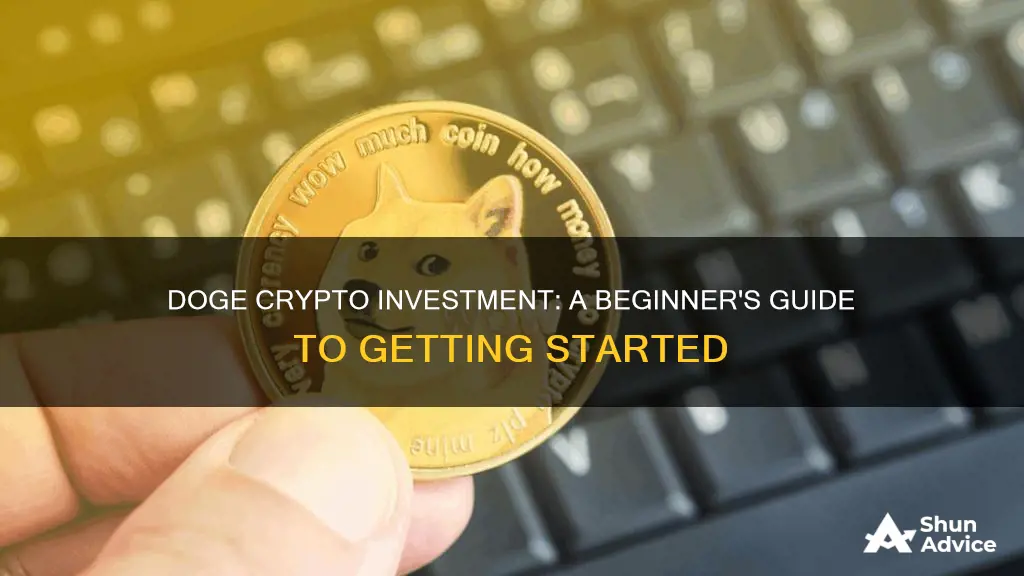
Dogecoin (DOGE) is a cryptocurrency that was created as a joke in 2013, poking fun at the wild speculation in the crypto market at the time. Despite its light-hearted origins, Dogecoin has gained significant attention due to its meme-inspired branding and support from high-profile figures like Elon Musk.
Investing in Dogecoin, like any cryptocurrency, carries risks due to its highly volatile nature. However, for those interested in adding this meme coin to their portfolio, there are several steps to buying and investing in Dogecoin. This includes creating an account on a reputable cryptocurrency exchange, verifying your identity, depositing funds, and then purchasing Dogecoin on the exchange.
It's important to do your due diligence and thoroughly research Dogecoin and the crypto market before making any investment decisions.
| Characteristics | Values |
|---|---|
| How to buy Dogecoin | Sign up for a crypto exchange, verify your account, deposit funds, and buy Dogecoin |
| How to buy Dogecoin on Binance | Register via the Binance app or website, choose a payment method, and place your order |
| Dogecoin creators | Billy Markus and Jackson Palmer |
| Dogecoin launch date | December 6, 2013 |
| Dogecoin's price as of September 15, 2024 | $0.104858 per DOGE/USD |
| Dogecoin's market cap as of September 15, 2024 | $15.31 billion USD |
| Dogecoin's 24-hour trading volume as of September 15, 2024 | $358.40 million USD |
| Dogecoin's circulating supply | 145.96 billion |
| Dogecoin's ranking as of September 15, 2024 | #8 |
What You'll Learn

How to buy Dogecoin
Dogecoin is a decentralised, peer-to-peer cryptocurrency, created as a joke in 2013, that has gained significant attention due to its meme-inspired branding and support from Tesla CEO Elon Musk. It is available on most crypto exchanges.
Step 1: Sign up for a crypto exchange
Create an account on a well-known cryptocurrency exchange, such as Coinbase, Kraken, or Binance, by providing information like your email address, name, and phone number.
Step 2: Verify your account
Verify your account with personal details like proof of address. You may also need to undergo a Know Your Customer (KYC) verification process.
Step 3: Deposit funds to your account
You can deposit money into your cryptocurrency account through various methods, such as credit or debit cards, bank transfers, or PayPal transfers, depending on the exchange's policies and your jurisdiction.
Step 4: Find DOGE, check the market price, and buy
Search for Dogecoin (DOGE) on the exchange, check its market price, and make a purchase. Generally, it takes less than a minute before you can see DOGE in your crypto exchange wallet. After making the purchase, you can transfer your Dogecoin to your other wallets.
Alternative Ways to Buy Dogecoin
You can also buy Dogecoin through peer-to-peer (P2P) marketplaces, which allow you to buy directly from other individuals instead of using a centralised exchange. These platforms match buyers and sellers and provide a secure escrow system to facilitate the transaction.
Another way is by exchanging Dogecoin with other forms of crypto in your wallet. For example, if you have Bitcoin or Ethereum, you can exchange them for Dogecoin on exchanges like Uniswap and Kraken. This method can be faster and more cost-effective than buying DOGE with fiat currency.
A Beginner's Guide to Investing in Ripple Coin
You may want to see also

Dogecoin's creators and history
Dogecoin was created by software engineers Billy Markus and Jackson Palmer and introduced on December 6, 2013. Markus was working at IBM, while Palmer was at Adobe Systems in Sydney, Australia. The two creators decided to create a payment system as a joke, satirising the wild speculation in cryptocurrencies at the time. Dogecoin was based on existing cryptocurrencies Luckycoin and Litecoin, which use scrypt technology in their proof-of-work algorithm.
Dogecoin quickly developed its own online community, reaching a peak market capitalisation of over US$85 billion on May 5, 2021. Its logo is the face of Kabosu from the "doge" meme, and its name is also derived from this.
Dogecoin's early success was driven by Reddit, where it became an instant hit. Within two weeks, Dogecoin had established a dedicated blog and forum, and its market value reached $8 million, briefly becoming the seventh-largest electronic currency in the world.
Dogecoin has since gained a dedicated fanbase, known as the "Doge Army". Celebrities such as Elon Musk, Snoop Dogg, and Gene Simmons have also promoted the cryptocurrency on Twitter.
Dogecoin: A Long-Term Investment Worth Your Money?
You may want to see also

How Dogecoin works
Dogecoin is a peer-to-peer, open-source cryptocurrency, similar to Bitcoin, that provides its users with a completely unknown, decentralised, and secure environment that is free from any third-party interference when it comes to transactions.
Like other cryptocurrencies, Dogecoin runs on blockchain technology. Blockchain is a distributed and secure digital ledger that stores all transactions made by any cryptocurrency, free from centralised authority. All the users of the Dogecoin network have a digital wallet that consists of two keys: a public key and a private key.
To request a transaction, you need to know the wallet ID and public key of the other person. Once the request is made, the application alerts all Dogecoin miners worldwide to proceed with the transaction. The miners validate whether the sender has enough Dogecoins to make the payment, and then they approve the transaction request.
Miners worldwide then compete to collect all the pending transaction data, known as the nonce. They apply a mathematical function to produce the correct hash number for that particular nonce of the pending transaction. The miner who successfully produces the correct hash number is rewarded with 25 Dogecoins in their account. After that, both users get a confirmation message that their transaction request has been approved. Within a few minutes, the requested amount of Dogecoin is credited to the receiver's wallet, and the transaction is completed.
The Ultimate Guide to Investing Bitcoin with Fidelity
You may want to see also

How to mine Dogecoin
Mining Dogecoin involves using computers to solve mathematical puzzles and add blocks to the Dogecoin blockchain. It is similar to mining other cryptocurrencies like Ether and Bitcoin. Dogecoin is a decentralised cryptocurrency, and its digital ledger is maintained by a decentralised network of nodes instead of a single party.
Mining Dogecoin requires the provision of processing power, also known as hashpower, to the Dogecoin network. In the early days, it was possible to mine Dogecoin using a home CPU or GPU. However, due to its surge in popularity, more hashpower is now being provided to the network, making mining more difficult. Today, at least a powerful GPU or an Application-Specific Integrated Circuit (ASIC) mining machine is required to provide relevant hashpower.
ASIC miners are devices optimised to perform one specific task – in this case, calculating as many hashes as possible over a short period. This gives miners more chances of finding the proper hash for a block. They are generally very expensive, difficult to obtain, and require experience to set up and house properly.
Joining a mining pool is the easiest way to start mining Dogecoin. A mining pool allows miners to combine their hashing power with that of other miners, increasing the chances of receiving a steady flow of block rewards. Most mining pools also allow for merged mining, which lets miners participate in the mining of multiple cryptocurrencies at once without splitting their hashpower.
To mine Dogecoin profitably, you will typically need:
- A Windows/Linux/Mac OS computer
- One or more ASIC miners for Scrypt-based cryptocurrencies
- Power supplies for your ASIC miners
- An account with a mining pool
- Access to relatively cheap electricity
- A Dogecoin wallet where the mining pool will send your mining rewards
- Purchase mining hardware: Acquire ASIC miners designed for scrypt-based algorithms, or check if your CPU/GPU is suitable for mining.
- Install mining software/update drivers: Download and install the necessary software and update GPU drivers if needed.
- Join a mining pool: Sign up for an account with a suitable mining pool.
- Connect your devices to the pool: Use your mining pool account to connect your mining machines to the pool's servers.
- Set up a Dogecoin wallet: Register your payout address with your pool account to collect revenue from block rewards.
- Start mining: Once everything is set up, monitor your hashrate, revenue, and payout through your mining pool account.
Bitcoin Cash: Late Investment, Late Regret?
You may want to see also

Dogecoin wallets
Wallets can also be 'hot' or 'cold', depending on whether they are connected to the internet or not. Hot wallets are generally considered to be less secure, as they are susceptible to hacking. Cold wallets, on the other hand, are considered to be more secure as they are not connected to the internet.
There are several types of Dogecoin wallets available, including:
- DogeWallet (Dogeparty wallet)
- Dogecoin Core
- Browser extension wallets (e.g. MetaMask)
- Smartphone wallets
- Hardware wallets
- Paper wallets
Robinhood Crypto: A Beginner's Guide to Investing
You may want to see also
Frequently asked questions
Dogecoin (DOGE) is a decentralised cryptocurrency based on the ""doge" internet meme, featuring a Shiba Inu on its logo. It was created by Billy Markus and Jackson Palmer in 2013 as a joke, poking fun at the wild speculation in the crypto market at the time.
To invest in Dogecoin, you need to create an account on a crypto exchange that lists Dogecoin, such as Coinbase, Kraken, or Binance. After verifying your account and depositing funds, you can search for Dogecoin (DOGE) on the exchange, check its market price, and make a purchase.
Like all cryptocurrencies, investing in Dogecoin is risky and highly speculative. Dogecoin is highly volatile, with billions of new coins being minted each year. Its value is largely determined by its popularity, which can lead to exciting short-term gains but is not a sustainable strategy for long-term investing success.







